Prysmian Bundle
How did Prysmian Group become a global leader?
Journey through the Prysmian SWOT Analysis and discover the fascinating Prysmian history of a company that has powered the world for over a century. From its humble beginnings in Italy, Prysmian Group has evolved into a powerhouse in cable manufacturing and telecommunications, shaping the modern world's infrastructure. Explore the pivotal moments that defined this Italian company and its remarkable rise.
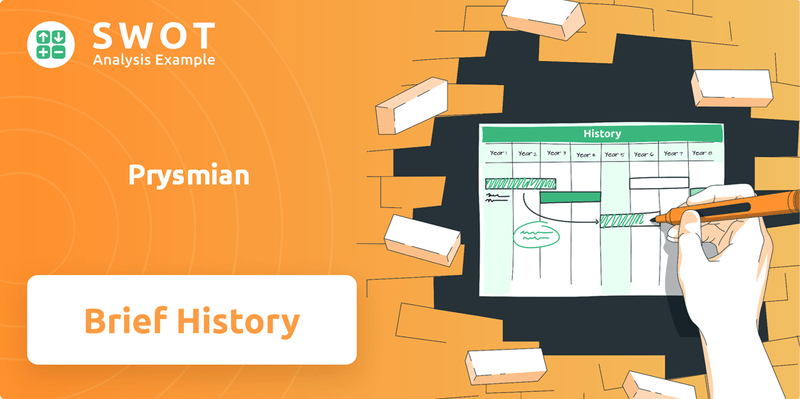
Understanding the Prysmian company's past is crucial for grasping its present and anticipating its future. This deep dive into the Prysmian Group founding and its evolution will reveal how strategic acquisitions, technological innovations, and a commitment to sustainability have cemented its position in the telecom cables and energy sectors. Learn about the Prysmian Group timeline and the key figures behind its success, providing valuable insights for investors and business strategists alike.
What is the Prysmian Founding Story?
The story of the Prysmian Group, a global leader in the cable industry, begins in 1879. This marks the establishment of Pirelli Cavi e Sistemi in Milan, Italy. This pivotal moment set the stage for the company's evolution into a major player in the cable manufacturing sector.
The company's initial focus was on the design, development, and production of electrical and telecommunications cables. This early emphasis on specialized cable solutions quickly established the company's importance in national infrastructure development. Pirelli Cavi e Sistemi played a crucial role in laying the Italian telegraph network and installing the electrical grid for domestic use in Milan.
Pirelli Cavi e Sistemi's early success was fueled by its ability to meet the growing demand for reliable cable infrastructure. This included submarine telegraph cables, with a significant contract secured in 1881 for military engineering applications. The company's expansion extended internationally, including laying telegraph cables in Italian East African colonies and producing a substantial amount of submarine telegraph cabling in 1925.
Prysmian Group's roots trace back to 1879 with Pirelli Cavi e Sistemi. The company's early focus was on electrical and telecommunications cables, including submarine telegraph cables.
- Established in Milan, Italy, during a period of industrial and technological advancement.
- Secured a contract in 1881 for military engineering applications.
- Played a crucial role in the Italian telegraph network and Milan's electrical grid.
- Expanded internationally, including laying cables in Italian East African colonies.
Prysmian SWOT Analysis
- Complete SWOT Breakdown
- Fully Customizable
- Editable in Excel & Word
- Professional Formatting
- Investor-Ready Format
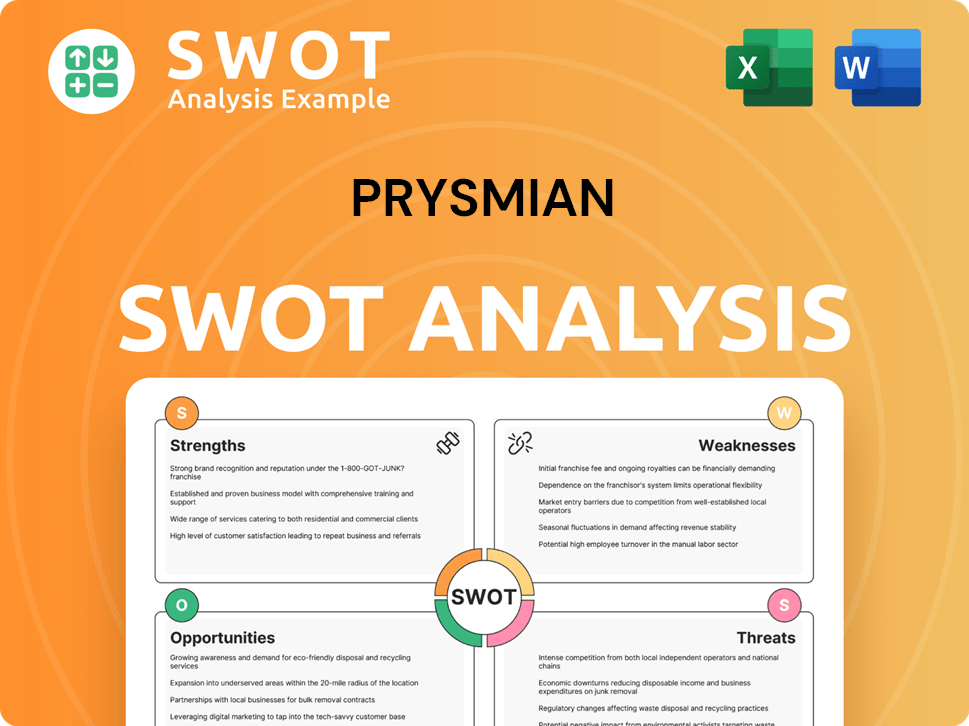
What Drove the Early Growth of Prysmian?
The early growth of the Prysmian Group, then known as Pirelli Cavi e Sistemi, was characterized by its essential role in developing critical infrastructure. From its founding in 1879, the Prysmian company rapidly expanded its operations. This expansion included significant contracts and investments in cable manufacturing, establishing itself as a key player in the industry. The company's early successes laid the groundwork for its future growth and global presence.
In 1881, the Prysmian company secured a major contract for submarine telegraph cables, which was essential for military engineering. By 1886, the company had established a specific production plant for submarine cables in La Spezia. These early projects were critical in establishing the company's expertise in cable manufacturing and its ability to handle large-scale infrastructure projects.
The Prysmian company played a vital role in laying the entire Italian telegraph network for the state-owned Telegrafi dello Stato. It was also involved in installing Milan's domestic electrical grid. These projects highlighted the company's contribution to Italy's technological advancement and its expansion into new markets.
The Prysmian Group extended its reach internationally with telegraph cable installations in Italian East Africa. A significant project in 1925 involved a 5,150 km submarine telegraph cabling project for Italcable, connecting Italy and South America. This expansion demonstrated the company's capabilities and its growing global presence in the telecom cables sector.
In 2005, Goldman Sachs acquired Pirelli & C. S.p.A.'s Cables and Systems business, leading to the creation of Prysmian S.r.l. Under the leadership of Valerio Battista, the company went public in 2007, listing on the Milan Stock Exchange and joining the S&P MIB index. This transition marked a strategic shift for the Italian company.
The acquisition of Draka in 2011 for €840 million expanded Prysmian's product offerings and global footprint. In 2018, the acquisition of General Cable for approximately $3 billion further solidified its market position, especially in North America. These acquisitions have been crucial in shaping Prysmian's trajectory.
These strategic moves, combined with ongoing investments in research and development, have allowed the Prysmian Group to adapt to market demands. The company continues to maintain its leadership in the energy and telecom sectors. To understand the competitive landscape, see the Prysmian Group's competitive analysis.
Prysmian PESTLE Analysis
- Covers All 6 PESTLE Categories
- No Research Needed – Save Hours of Work
- Built by Experts, Trusted by Consultants
- Instant Download, Ready to Use
- 100% Editable, Fully Customizable
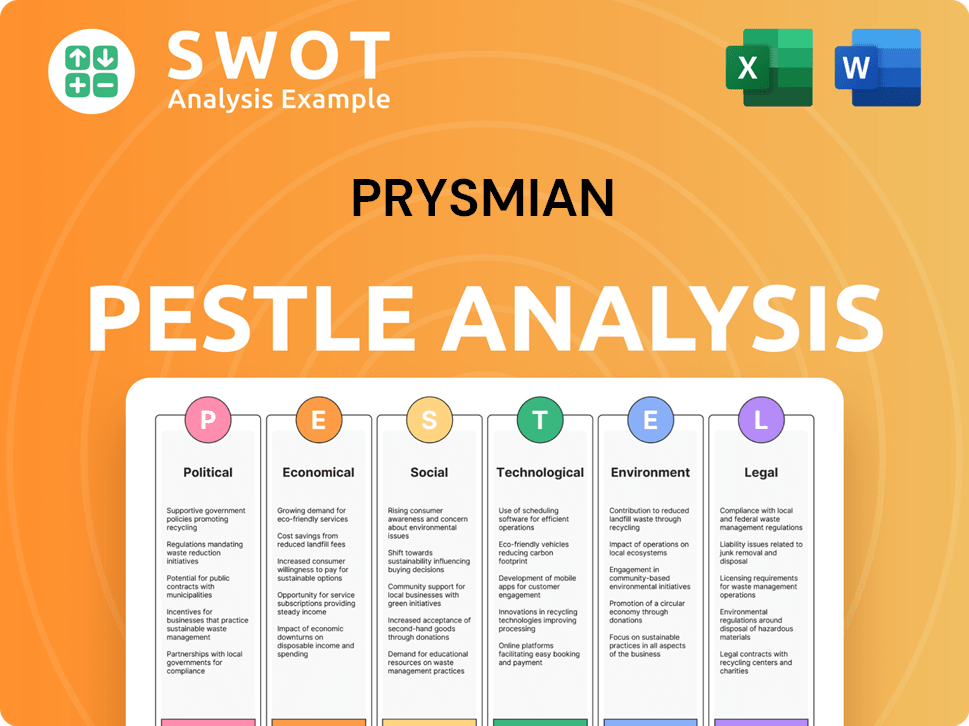
What are the key Milestones in Prysmian history?
The Prysmian Group has a rich Prysmian history marked by significant milestones. From its early involvement in laying Italian telegraph networks to its strategic acquisitions and technological advancements, the Prysmian company has consistently evolved.
| Year | Milestone |
|---|---|
| Late 19th/Early 20th Century | Involved in laying the Italian telegraph network and electrical grids, establishing its early infrastructure role. |
| 1925 | Produced 5,150 km of submarine telegraph cabling for communication between Italy and South America. |
| 2005 | Created Prysmian S.r.l. after Goldman Sachs acquired Pirelli's cable business, becoming a standalone entity. |
| 2007 | Listed on the Milan Stock Exchange, a key step in its corporate development. |
| 2011 | Acquired Draka, combining two industry leaders to form Prysmian Group, expanding its global reach. |
| 2018 | Acquired General Cable, reinforcing its position as a global leader in cable manufacturing. |
| 2025 | Decision not to proceed with a planned USD 200 million offshore wind cable factory in Massachusetts. |
Prysmian Group's commitment to innovation is evident through its extensive patent portfolio and technological advancements. The company has a strong focus on developing high-tech products, particularly in the energy and telecom sectors.
Prysmian boasts over 7,800 patents worldwide, with more than 5,400 granted, demonstrating its dedication to innovation.
Recent innovations include the development of 525 kV HVDC submarine cable systems, designed to significantly increase transmission capacity for offshore renewable energy.
The company is a leader in optical fiber technology, holding industry records for fiber count and density in telecom cables.
Prysmian invested around €300 million in R&D over 2013-2016, with ongoing investments in 2022 and 2023 totaling €220 million in Finland alone.
Despite its successes, Prysmian has faced challenges, including market downturns and intense competition. The company has also had to manage issues such as patent infringement lawsuits and adapt to changing market demands.
Electrification experienced a -2.8% organic growth contraction, and Digital Solutions saw a -12.6% organic growth contraction in 2024, affecting overall sales.
Prysmian has contended with patent infringement lawsuits to protect its R&D investments, impacting its ability to maintain its competitive edge.
Prysmian decided not to proceed with a planned USD 200 million offshore wind cable factory in Massachusetts, shifting focus to data center and energy demand opportunities.
Prysmian Business Model Canvas
- Complete 9-Block Business Model Canvas
- Effortlessly Communicate Your Business Strategy
- Investor-Ready BMC Format
- 100% Editable and Customizable
- Clear and Structured Layout
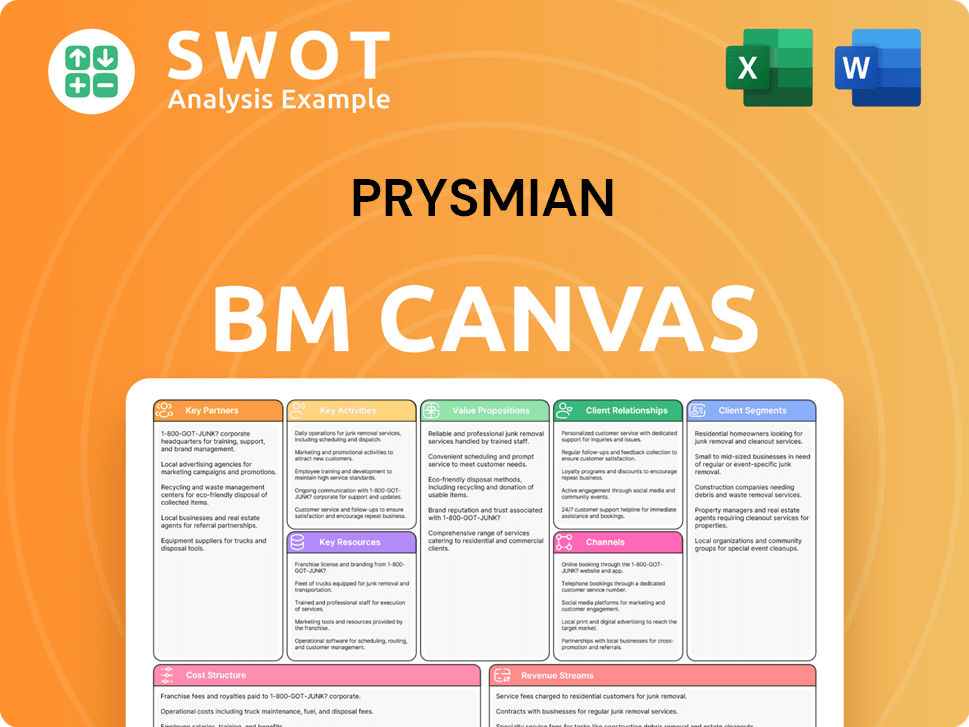
What is the Timeline of Key Events for Prysmian?
The Prysmian Group, a global leader in the cable industry, has a rich history marked by strategic growth and innovation. From its origins as Pirelli Cavi e Sistemi in 1879, the Italian company has evolved significantly, adapting to technological advancements and market demands. Key milestones include early contracts for submarine cables, significant production milestones, and strategic acquisitions that expanded its global presence. Recent investments in production capacity and a focus on sustainable practices further highlight its commitment to the future.
| Year | Key Event |
|---|---|
| 1879 | Originated as Pirelli Cavi e Sistemi in Milan, Italy, marking the beginning of the Prysmian history. |
| 1881 | Secured a contract for submarine telegraph cables, starting its involvement in telecom cables. |
| 1886 | Opened a submarine cable production plant in La Spezia, expanding its cable manufacturing capabilities. |
| 1925 | Produced 5,150 km of submarine telegraph cabling for Italcable, connecting Italy and South America. |
| 2005 | Prysmian S.r.l. was created by Goldman Sachs, acquiring Pirelli's Cables and Systems business. |
| 2007 | Listed on the Milan Stock Exchange as Prysmian S.p.A. |
| 2011 | Acquired Draka, forming Prysmian Group. |
| 2017-2018 | Acquired General Cable, further solidifying its global leadership. |
| 2023 | Invested €22.5 million in its Williamsport manufacturing facility in the U.S. and €120 million in its Pikkala, Finland plant. |
| 2024 (February 27) | Reported 2024 revenues of €17.026 billion, with an adjusted EBITDA of €1.927 billion. |
| 2024 (April 18) | Massimo Battaini confirmed as the new CEO and General Manager. |
| 2025 (January 1) | Implemented a new organizational structure, reducing regions from nine to five. |
| 2025 (March 25) | Capital Markets Day in New York City, where leadership presented strategic plans and future targets. |
| 2025 (Q1) | Reported Q1 2025 revenues of €4,771 million, up from €3,687 million in Q1 2024, with adjusted EBITDA reaching €527 million. |
| 22 May 2025 | John Andrews appointed as Prysmian's Chief HR & Organisation Officer. |
Prysmian Group forecasts a 4.3% revenue CAGR from 2025-2027. This growth is driven by global trends in electrification, energy transition, and digitalization. The company is strategically positioned to capitalize on these opportunities within the energy sector and the telecom industry.
Prysmian aims to maintain an adjusted EBITDA margin of around 11.2%. For 2025, the company anticipates an adjusted EBITDA in the range of €2,250–€2,350 million. Free cash flow is expected to be between €950-€1,050 million, demonstrating strong financial performance.
The Transmission segment is a key growth driver. The global market value is projected to be between €15 billion and €20 billion annually from 2025-2030. Prysmian aims for a 25% to 28% CAGR in Transmission adjusted EBITDA from 2024-2028.
Prysmian plans to invest approximately €2.6 billion in capital expenditures over the 2025-2028 period. The company is committed to reducing Scope 1 & 2 GHG emissions by 38%-40% by 2025 compared to 2019 levels, highlighting its focus on sustainability.
Prysmian Porter's Five Forces Analysis
- Covers All 5 Competitive Forces in Detail
- Structured for Consultants, Students, and Founders
- 100% Editable in Microsoft Word & Excel
- Instant Digital Download – Use Immediately
- Compatible with Mac & PC – Fully Unlocked
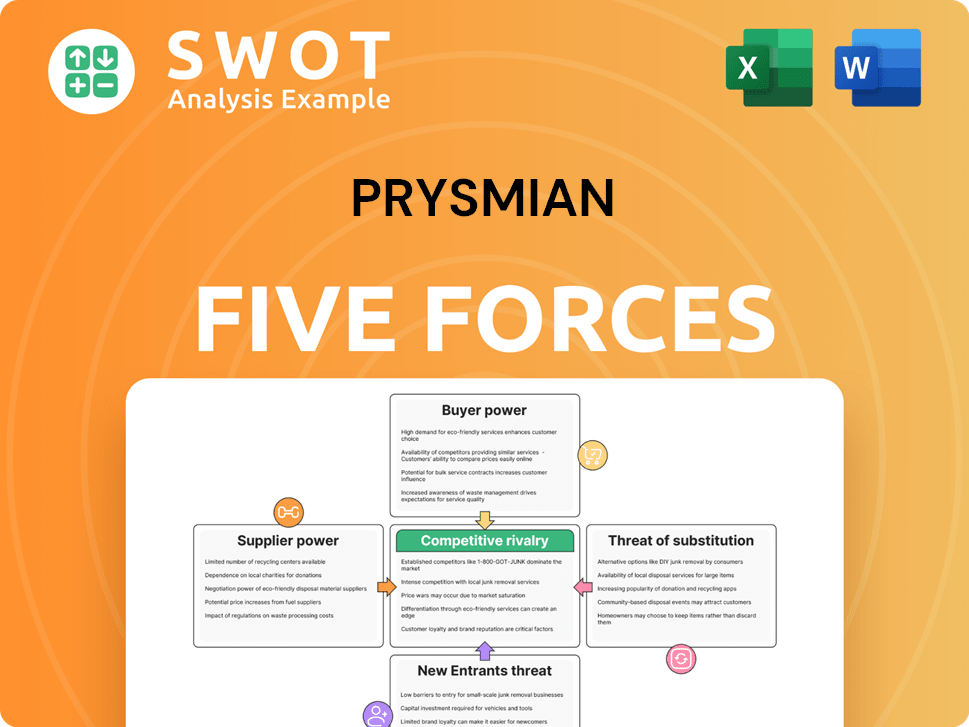
Related Blogs
- What is Competitive Landscape of Prysmian Company?
- What is Growth Strategy and Future Prospects of Prysmian Company?
- How Does Prysmian Company Work?
- What is Sales and Marketing Strategy of Prysmian Company?
- What is Brief History of Prysmian Company?
- Who Owns Prysmian Company?
- What is Customer Demographics and Target Market of Prysmian Company?
Disclaimer
All information, articles, and product details provided on this website are for general informational and educational purposes only. We do not claim any ownership over, nor do we intend to infringe upon, any trademarks, copyrights, logos, brand names, or other intellectual property mentioned or depicted on this site. Such intellectual property remains the property of its respective owners, and any references here are made solely for identification or informational purposes, without implying any affiliation, endorsement, or partnership.
We make no representations or warranties, express or implied, regarding the accuracy, completeness, or suitability of any content or products presented. Nothing on this website should be construed as legal, tax, investment, financial, medical, or other professional advice. In addition, no part of this site—including articles or product references—constitutes a solicitation, recommendation, endorsement, advertisement, or offer to buy or sell any securities, franchises, or other financial instruments, particularly in jurisdictions where such activity would be unlawful.
All content is of a general nature and may not address the specific circumstances of any individual or entity. It is not a substitute for professional advice or services. Any actions you take based on the information provided here are strictly at your own risk. You accept full responsibility for any decisions or outcomes arising from your use of this website and agree to release us from any liability in connection with your use of, or reliance upon, the content or products found herein.